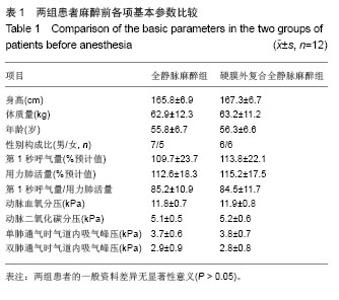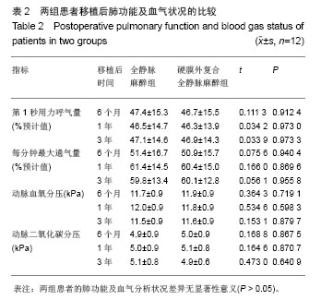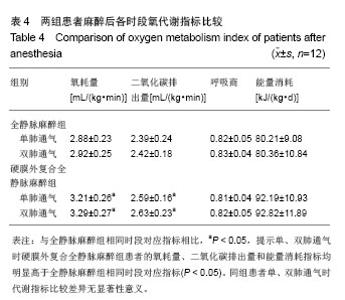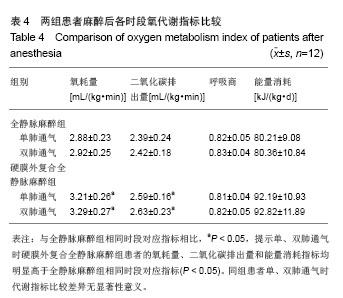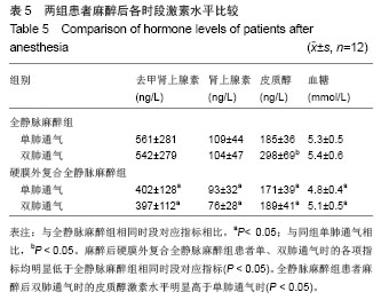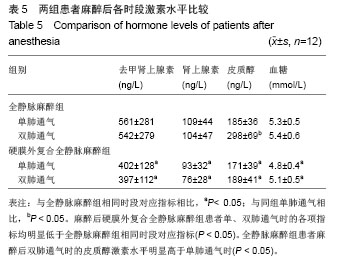Chinese Journal of Tissue Engineering Research ›› 2014, Vol. 18 ›› Issue (27): 4304-4309.doi: 10.3969/j.issn.2095-4344.2014.27.008
Previous Articles Next Articles
Effect of anesthetic methods on respiratory and lung functions of patients after sequential double lung transplantation
Huang Le-lin
- Department of Anesthesiology, the 171 Hospital of Chinese PLA, Jiujiang 332000, Jiangxi Province, China
-
Online:2014-06-30Published:2014-06-30 -
About author:Huang Le-lin, Associate chief physician, Department of Anesthesiology, the 171 Hospital of Chinese PLA, Jiujiang 332000, Jiangxi Province, China
CLC Number:
Cite this article
Huang Le-lin. Effect of anesthetic methods on respiratory and lung functions of patients after sequential double lung transplantation[J]. Chinese Journal of Tissue Engineering Research, 2014, 18(27): 4304-4309.
share this article
| [1]Hudson CO.Complete transvaginal surgical management of multiple bladder calculi and obstructed uterine procidentia. Female Pelvic Med Reconstr Surg. 2014;20(1):59-61.
[2]A??k M.Co-occurrence of Papillary and Follicular Thyroid Carcinoma in a Patient with Hodgkin's Disease.Turk J Haematol. 2013;30(2):209-210.
[3]Ozyuvaci E.Preoperat?ve ultrasound-gu?ded suprascapular nerve block for postthoracotomy shoulder pa?n.Curr Ther Res Clin Exp. 2013;74:44-48.
[4]Ali Erdogan M.Effects of perineural administration of dexmedetomidine in combination with levobupivacaine in a rat sciatic nerve block.Curr Ther Res Clin Exp. 2013;74:74-78.
[5]Yin Y.Propofol enhances the field excitatory postsynaptic potentials in CA1 hippocampal slices of young and aged mice.Chin Med J (Engl). 2014;127(1):137-141.
[6]Khan MA.Nonsurgically induced disuse muscle atrophy and neuromuscular dysfunction upregulates alpha7 acetylcholine receptors.Can J Physiol Pharmacol. 2014;92(1):1-8.
[7]马文,朱余明,周红,等.针药复合麻醉中不同频率电针对肺切除患者应激反应的保护作用[J].中国针灸,2011,31(11):1020-1024.
[8]Navaratnarajah J.Previously unreported difficult intubation in a child with Pitt-Hopkins syndrome.Paediatr Anaesth. 2013; 23(12):1226-1227.
[9]Peters SM.Tobacco control education in pediatric anesthesiology fellowships.Paediatr Anaesth. 2013;23(12):1213-1218.
[10]Tan GM.Laryngeal view and temperature measurements while using the perilaryngeal airway (Cobra-PLUS™) in children.Paediatr Anaesth. 2013;23(12):1180-1186.
[11]Lertsirivorakul J.Oral manifestations and dental management of a child with Zellweger syndrome.Spec Care Dentist. 2014; 34(1):46-50.
[12]Actis AG.Surgical anatomy of the orbital region, local anesthesia and general considerations.Minerva Chir. 2013; 68(6 Suppl 1):1-9.
[13]Meretoja TJ.Pain at 12 months after surgery for breast cancer. JAMA. 2014;311(1):90-92.
[14]Ekmekçi P.The efficacy of submucosal tramadol in the postoperative treatment of pain following septoplasty operations. Indian J Otolaryngol Head Neck Surg. 2013;65(1): 12-15.
[15]Joshi VP.Giant posterior fossa arachnoid cyst causing tonsillar herniation and cervical syringomyelia.J Craniovertebr Junction Spine.2013;4(1):43-45.
[16]Ramsay MA.Sedation levels during propofol administration for outpatient colonoscopies.Proc (Bayl Univ Med Cent). 2014;27(1):12-15.
[17]Webb JA.The use of medetomidine-based sedation protocols to perform urohydropropulsion and cystoscopy in the dog.Can Vet J. 2014;55(1):1213-1218.
[18]Chung Y.Coding of Electric Pulse Trains Presented through Cochlear Implants in the Auditory Midbrain of Awake Rabbit: Comparison with Anesthetized Preparations.J Neurosci. 2014; 34(1):218-231.
[19]Corcoran AE.Dual Effects of 5-HT1a Receptor Activation on Breathing in Neonatal Mice.J Neurosci. 2014;34(1):51-59.
[20]傅国强,周嘉,童秋瑜,等.针药复合麻醉在肺切除术中抗应激作用的临床研究[J].针刺研究,2011,36(5):361-365.
[21]Basile F.Surgical approach to abdominal wall defects: history and new trends.Int J Surg. 2013;11 Suppl 1:S20-23.
[22]Vigg A.Intra-pulmonary teratoma: a rare case.Indian J Chest Dis Allied Sci. 2013;55(3):155-157.
[23]Craig C.What's in your manager bag of tricks?MGMA Connex. 2013;13(9):20-21.
[24]Gregersen M.Limitations of Mild, Moderate, and Profound Hypothermia in Protecting Developing Hippocampal Neurons After Simulated Ischemia.Ther Hypothermia Temp Manag. 2013;3(4):178-188.
[25]Bajwa S.Dexmedetomidine: An Adjuvant Making Large Inroads into Clinical Practice.Ann Med Health Sci Res. 2013;3(4):475-483.
[26]Park CK.Tapia's Syndrome after Posterior Cervical Spine Surgery under General Anesthesia.J Korean Neurosurg Soc. 2013;54(5):423-425.
[27]Uceda PR.Fluoride Exposure, Caregiver Education, and Decayed, Missing, Filled Teeth (dmft) in 2-5 year-old English or Spanish Speaking Children.Open Dent J. 2013;7:175-180.
[28]樊文朝,马文,赵创,等.针药复合麻醉中不同频率电针对肺切除患者免疫功能的影响[J].中国针灸,2012,32(8):715-719.
[29]Ghaderi F.Effect of pre-cooling injection site on pain perception in pediatric dentistry: "A randomized clinical trial".Dent Res J (Isfahan). 2013;10(6):790-794.
[30]Rahimzadeh P.Effectiveness of adding ketamine to ropivacaine infusion via femoral nerve catheter after knee anterior cruciate ligament repair.J Res Med Sci. 2013;18(8):632-636.
[31]Ganesh A.Spontaneously resolving macular cyst in an infant.Oman J Ophthalmol. 2013;6(3):203-205.
[32]Reddy A.Adenosine stress myocardial perfusion scintigraphy in pediatric patients after arterial switch operation.Indian J Nucl Med. 2013;28(4):210-215.
[33]Kambali M.Traumatic posterior atlantoaxial dislocation without related fractures of C1-C2.Indian J Orthop. 2013; 47(6): 624-629.
[34]Oztürk I.Biochemical markers in total intravenous anesthesia and propofol infusion syndrome: a preliminary study.Eur Rev Med Pharmacol Sci. 2013;17(24):3385-3390.
[35]Haque S.Entwinement of Sciatic Nerve around a total hip prosthesis following closed reduction of dislocated total hip replacement.Pol Orthop Traumatol. 2013;78:273-275.
[36]Akita H.Reduced Port Surgery for Prostate Cancer is Feasible: Comparative Study of 2-port Laparoendoscopic and Conventional 5-port Laparoscopic Radical Prostatectomy.Asian Pac J Cancer Prev. 2013;14(11):6311-6314.
[37]Karamitsos A.Ocular surface and tear film abnormalities in women under adjuvant chemotherapy for breast cancer with the 5-Fluorouracil, Epirubicin and Cyclophosphamide (FEC) regimen.Hippokratia. 2013;17(2):120-125.
[38]Dualé C. Neuropathic aspects of persistent postsurgical pain: a French multicenter survey with a 6-month prospective follow-up.J Pain. 2014;15(1):24.e1-24.e20.
[39]Wisborg T.Air ambulance nurses as expert supplement to local emergency services. Air Med J. 2014;33(1):40-43.
[40]Hu P.Identification of dynamic prehospital changes with continuous vital signs acquisition.Air Med J. 2014;33(1):27-33.
[41]Derakhchan K.Detection of QTc interval prolongation using jacket telemetry in conscious non-human primates: comparison with implanted telemetry.Br J Pharmacol. 2014; 171(2):509-522.
[42]Rivi? M.Giant maxillary cyst with intrasinusal evolution.Rom J Morphol Embryol. 2013;54(3 Suppl):889-892.
[43]彭科,李文静,姜亚辉,等.丙泊酚全凭静脉麻醉与七氟醚吸入麻醉对患者肺功能的影响[J].重庆医学,2013,42(10):1148-1150.
[44]Boia ER.Non-keratinizing undifferentiated carcinoma of the nasopharynx.Rom J Morphol Embryol. 2013;54(3Suppl):839-843.
[45]Cionac Florescu S.Venous Thromboembolism Following Major Orthopedic Surgery.Maedica (Buchar). 2013;8(2): 189-194.
[46]Toma N.Worsening of Heart Failure after Abdominal Surgery - Can we predict it?Maedica (Buchar). 2013;8(2):124-128.
[47]Khanykin B.Comparison of remifentanil and low-dose fentanyl for fast-track cardiacanesthesia: a prospective randomized study.Heart Surg Forum. 2013;16(6):E324-328.
[48]McQueen KA.The global anesthesia crisis and continuous quality improvement.Int Anesthesiol Clin. 2014;52(1):109-119.
[49]杨昌明,肖少华,余凡华,等.丙泊酚与异氟醚分别复合瑞芬太尼用于单肺通气麻醉的比较[J].临床麻醉学杂志,2012,28(3): 292-293.
[50]Guffey PJ.Incident reporting at the local and national level.Int Anesthesiol Clin. 2014;52(1):69-83.
[51]Tung A.Sentinel events and how to learn from them.Int Anesthesiol Clin. 2014;52(1):53-68.
[52]Vakharia SB.Using Anesthesia AIMS Data in Quality Management.Int Anesthesiol Clin. 2014;52(1):42-52.
[53]Dutton RP.Registries of the anesthesia quality institute.Int Anesthesiol Clin. 2014;52(1):1-14.
[54]Browne J.History of anaesthesia: anaesthetics and the Spanish Civil War: The start of specialisation.Eur J Anaesthesiol. 2014;31(2):65-67. |
| [1] | Li Ling1, Xu Qian1, Wei Wan-hui1, Zhao Hui-jia1, Shi Yu-ying1, Liu Lu1, Wang Yan-feng1, Ye Qi-fa1, 2 . Lung injury and inflammatory responses in a rabbit model of brain death [J]. Chinese Journal of Tissue Engineering Research, 2018, 22(28): 4481-4486. |
| [2] | Wang Si-ya, Zhuang Jie, Zhu Zheng. SenseWear Pro Armband: a monitoring device of physical activity energy consumption [J]. Chinese Journal of Tissue Engineering Research, 2015, 19(42): 6843-6848. |
| [3] | Liu Jing, Li Li, Ran Jiang-hua, Zhang Sheng-ning, Li Lai-bang, Zhang Xi-bing, Gao Yang, Chen Yi-ming. Expression of hepatic energy proteins following reduced-size liver transplantation in rats [J]. Chinese Journal of Tissue Engineering Research, 2015, 19(18): 2874-2878. |
| [4] | Wei Xing, Cai Ming, Li Zhou-li, Jin Hai-long, Hong Xin, Chen Chang-qing, Shi Bing-yi. Methylprednisolone therapy for severe pulmonary infection after kidney transplantation [J]. Chinese Journal of Tissue Engineering Research, 2014, 18(5): 742-747. |
| [5] | Zhang Hao, Qi Hai. An animal model of lung transplantation: damage, protection and immune response [J]. Chinese Journal of Tissue Engineering Research, 2014, 18(5): 797-802. |
| [6] | Yang Ying, Huang Hai, Qiu Hong-zhong. Influence of traditional Chinese culture and ideas on organ donation [J]. Chinese Journal of Tissue Engineering Research, 2014, 18(5): 803-808. |
| [7] | Liu Jian-feng, Ding Yan-ping, Wang Jian-lin, Shao Bao-ping. Distribution, function and regulation mechanism of aquaporin in the brain [J]. Chinese Journal of Tissue Engineering Research, 2014, 18(2): 314-321. |
| [8] | Wang Jin-yi, Cao Hao, Hong Xuan, Chen Guo-han, Fan Hui-min, Li Qin-chuan, Liu Zhong-min. Differential expression profiles of microRNAs in a rat model of obliterative bronchiolitis [J]. Chinese Journal of Tissue Engineering Research, 2014, 18(18): 2855-2860. |
| [9] | Xia Bing, Wen Bing, Xu Hua-shan, Fu Guo-wei, Zhao Wen-zeng. Autologous pericardium patch repairs the aortic annulus to assist aortic valve replacement [J]. Chinese Journal of Tissue Engineering Research, 2013, 17(5): 761-768. |
| [10] | Li Chuan, Qi Feng, Liu Tong, Li Fu-xin, Wang Peng-zhi. Establishment of a mouse-rat cervical cardiac xenotransplantation model by cuff technique [J]. Chinese Journal of Tissue Engineering Research, 2013, 17(5): 859-865. |
| [11] | Yang Yong, Lin Hui, Wen Zhao-ke, Huang Ai-lan, Wen Hong, Huang Guo-yong, Hu Yan-yan. Myocardial ultrastructure and hemodynamic changes of donor heart preserved in normothemic beating status [J]. Chinese Journal of Tissue Engineering Research, 2013, 17(5): 851-858. |
| [12] | Shao Lian-bin, Yang Xiao-gang, Yang Hai-ping, Liu Wen-li, He Jin-xi, Bian Hong. Protective effect of Tanreqing injection on the lung during heart valve replacement [J]. Chinese Journal of Tissue Engineering Research, 2013, 17(5): 843-850. |
| [13] | Suo You-jun, Xu Hong-shan, Gong Li. Intensive care after transplantation [J]. Chinese Journal of Tissue Engineering Research, 2013, 17(44): 7797-7802. |
| [14] | Wu Yue-heng, Huang Huan-lei, Fan Rui-xin, Qi Zhou-cuo, Yao Li-ming, Wu Chang-li, Lu Ping-lan, Cheng An-heng, Xiao Xue-jun. Production and functional testing of polyurethane valve of the pediatric Luo-Ye pump [J]. Chinese Journal of Tissue Engineering Research, 2013, 17(31): 5607-5612. |
| [15] | Qiang Guang-liang, Bao Tong, Wen Huan-shun, Xiao Fei, Liang Chao-yang. Improvement of a rat lung transplantation model [J]. Chinese Journal of Tissue Engineering Research, 2013, 17(31): 5633-5638. |
| Viewed | ||||||
|
Full text |
|
|||||
|
Abstract |
|
|||||
